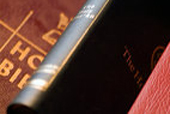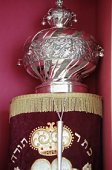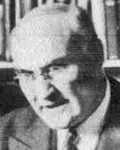|
|
|
|
||||
|
* In many places in the Scriptures, the believer is encouraged to study the written Word as the foundation for a holy, godly and fruitful life before God and man. But how are we to study this unified, but daunting, compilation of sixty-six books written by over forty authors between nineteen hundred and thirty-five hundred years ago in languages and cultures that may be totally foreign to us? Enter the science of hermeneutics. To understand hermeneutical principles is to be equipped for an intelligent study of the Word of God, tending greatly to our approval before God as workmen that do not need to be ashamed. Interpreting Scripture properly is a critical skill to master, particularly in an age in which the Babel of interpretations is legion. We have been treated to much sound instruction in this regard by Dr. David L. Cooper, founder of the Biblical Research Society, with "Rules of Interpretation" and "Messages Concerning the Laws of Interpretation." Let us continue to hone our skills with An Analysis of Figures of Speech that we might be clear and accurate voices for the Lord. To read or review prior studies, please see links in our Library. Let us now apply ourselves. - ed. |
||||||
|
|
|
|
||||
|
* AN ANALYSIS OF FIGURES OF SPEECH Message 5:
METONYMY *
THE FIGURE of metonymy is one that occurs very frequently in the Scriptures and should be understood if a person is to interpret the Scriptures correctly. This term is derived from two Greek words, a preposition and a noun. The former indicates change and the latter, name. Combined, they mean with a change of name. In other words, this figure is one which has a change of name in speaking of a certain event. There are different causes for the employment of this type of language. Regardless of the fundamental reason for the change in phraseology, the idea is a very definite one. Metonymy Of Cause And Effect Let us notice a few illustrations of this type. In Job 34:6 we read:
The marginal reading of the Revised Version on the expression My wound is, literally, Mine arrow. Job thinks of himself as being pierced with an arrow, which leaves a wound. This wound is incurable, but instead of speaking of the result of the stroke, in literal language, he speaks of the weapon which is used to produce it. This is doubtless an echo of his statement in 6:4:
It is clear from the context that Job is not talking about
literal arrows, but about something which caused him a deep
spiritual wound. Again, in Luke 16:29, and 24:27, we read of
Moses and the prophets, but an examination of the context of
each passage shows that these men were not in view at all, but
the books which they wrote. In other words, these books were the
result of their labors. Hence, by the figure of metonymy, the
authors of those books of the Bible are used in referring to
their writings. Metonymy Of Subject And Associated Ideas In Leviticus 19:32 we have this language: Thou shalt rise up before the hoary head, and honor the face of the old man, and thou shalt fear thy God: I am Jehovah. It is quite evident that the idea of gray hairs is associated with that of an old man, who is held in honor and respect. Thus the idea of hoary hairs is associated with the thought of an elderly gentleman who should be respected and honored. We find a very striking illustration of this same principle in Genesis 42:38. Joseph, who was then prime minister of Egypt, demanded that his brothers bring his brother Benjamin with them upon their coming again into the land. Jacob could not get the consent of his mind to allow Benjamin to go. He therefore said: My son shall not go down with you; for his brother is dead, and he only is left: if harm befall him by the way in which ye go, then will ye bring down my gray hairs with sorrow to Sheol. It is clear that he uses the expression, my gray hairs, in order to indicate that he was an old man and was on the verge of the grave. Thus he speaks of himself in terms of the associated idea of gray hairs. He felt that, by letting Benjamin go with them, probably something would befall him and the grief would be such a blow that he would succumb and never survive the ordeal. In the same general type of this figure is that which is mentioned in Exodus 12:21: Then Moses called for all the elders of Israel, and said unto them, Draw out, and take you lambs according to your families, and kill the passover. It is clear that the passover lamb is here meant, but there was associated with this lamb the historical occurrence the night when Israel left the land of Egypt. On that eventful night Israel killed a lamb which had a symbolic significance. Blood was sprinkled on the doorposts and lintels of every Hebrew home. God said, When I see the blood, I will pass over you. In every house of Egypt where there was no blood, the death angel slew the firstborn. Thus the lamb that was slain by each Hebrew family which was large enough for consuming one was called the passover. That ceremony was typical of Christ, the Lamb of God whose blood takes away the sin of the world. In Matthew 3:5 we have this language: Then went out unto him Jerusalem, and all Judea, and all the region round about the Jordan, ... Here we are told that Jerusalem and Judaea and certain sections round about the Jordan went out to hear John preach and to be baptized. It is clear that the people dwelling in those places are referred to in terms of the places where they lived. Again, we may look at Psalm 23:5: Thou preparest a table before me in the presence of mine enemies. Here the psalmist thinks of the Lord as a great Host who prepares a feast of good things for him to eat and does this in the presence of his enemies. But he speaks of the food which is set upon the table in terms of the table itself. Thus in this figure the psalmist spoke of God's vindicating him and taking his part in the presence of those who were his enemies. Again we have another example similar to this one in I Corinthians 10:21: Ye cannot drink the cup of the Lord, and the cup of demons: ye cannot take of the table of the Lord, and of the table of demons. People do not partake of the cup and eat of the table. They drink the contents of the cup and eat the food that is placed upon the table. In this instance, however, reference is made to the observance of what is called the Lord's supper, remembering the Lord and His death, burial, and resurrection until He comes, by partaking of the elements constituting the supper. We see the same figure in such an expression as for we were once darkness, but are now light in the Lord ... (Eph. 5:8). The idea of darkness and of light is associated with people. But since Paul was talking to Christians, he spoke of their being associated with light and of their being light and not darkness. Once again, in Psalm 45:2, the writer, seeing the Messiah in vision, said, Grace is poured into thy lips. By this he meant that there was proceeding out of the Messiah's mouth the message of grace and truth. Metonymy Of The Symbol And The Thing Signified In Isaiah 22:32 the Lord through Isaiah spoke to Eliakim
saying, And the key of the house of
David will I lay upon his shoulder; and he shall open, and none
shall shut; and he shall shut, and none shall open.
Here the key is the symbol of authority and power. Hence the
Lord spoke of the authority in terms of the symbol. The same
thing is true in Matthew 16:19 of the language to the Apostle
Peter: I will give unto thee the keys
of the kingdom of heaven and whatsoever thou shalt bind on earth
shall be bound in heaven; and whatsoever thou shalt loose on
earth shall be loosed in heaven. The Lord is using
the imagery of a city with its walls and gates. From times
immemorial the keys have been thought of as symbols of the
authority of the one in control of the city. Hence the Lord
spoke of the authority that He would grant to Peter in terms of
this common symbol. Once again, in Ezekiel 21:26 we have the
same figure; Thus saith the Lord
Jehovah: Remove the mitre, and take off the crown; this shall be
no more the same; exalt that which is low, and abase that which
is high. The crown here stands for the authority of
King Messiah. Finally, we find the same language in Isaiah 2:4:
And he will judge between the nations,
and will decide concerning many peoples; and they shall beat
their swords into plowshares, and their spears into
pruning-hooks; nation shall not lift up sword against nation,
neither shall they learn war any more. Here the sword
and spears symbolize, or signify, the weapons of war. The
plowshares and pruning-hooks represent the agricultural
implements. It is clear, then, that this is a figure of metonymy
and the idea is unmistakable. * This concludes our series on hermeneutics by David Cooper. All studies in this extensive series may be accessed in our Library. *
|
||||||


